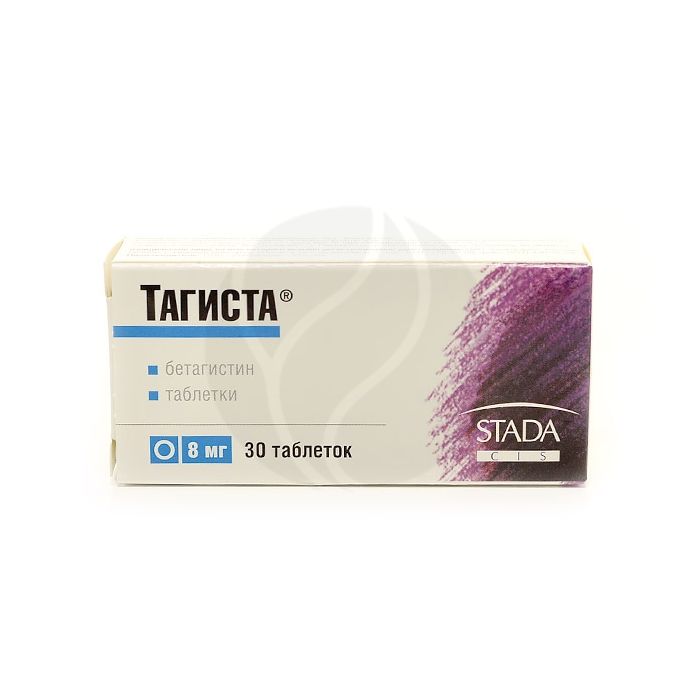Tagista tablets 8mg, No. 30
Expiration Date: 05/2027
Russian Pharmacy name:
Тагиста таблетки 8мг, №30
Treatment and prevention of vestibular vertigo of various origins:
syndromes including dizziness and headache, tinnitus, progressive hearing loss, nausea and vomiting:
Disease or Meniere's syndrome.
Inside, during meals.
Tablets 8 mg: 1-2 tablets 3 times a day.
Tablets 16 mg: 1 / 2-1 tablet 3 times a day.
Tablets 24 mg: 1 tablet 2 times a day.
Improvement is usually noted already at the beginning of therapy, a stable therapeutic effect occurs after two weeks of treatment and can increase over several months of treatment. The treatment is long-term. The duration of the course of treatment is determined individually.
active substance: betahistine dihydrochloride - 8.0 mg;
excipients: microcrystalline cellulose, povidone (kollidon 25), potato starch, citric acid, colloidal silicon dioxide (aerosil), talc, magnesium stearate.
Hypersensitivity to any of the components of the drug:
Age under 18 (due to lack of data);
Pregnancy and lactation (due to lack of data).
With care:
gastric ulcer or 12-duodenal ulcer (including history), pheochromocytoma. bronchial asthma. These patients should be monitored regularly during treatment.
Trade name of the drug: Tagista
International non-proprietary name:
betahistine.
Dosage form:
pills.
Composition:
active substance: betahistine dihydrochloride 8.0 mg; 16.0 mg; 24.0 mg;
excipients: microcrystalline cellulose, povidone (kollidon 25), potato starch, citric acid, colloidal silicon dioxide (aerosil), talc, magnesium stearate.
Description: tablets of almost white or white color with a creamy shade, flat-cylindrical with a beveled and scored.
Pharmacotherapeutic group:
a histamine drug.
PHARMACHOLOGIC EFFECT
Pharmacodynamics
Betahistine acts mainly on the histamine H1 and H3 receptors of the inner ear and the vestibular nuclei of the central nervous system. It improves microcirculation and capillary permeability by direct agonistic action on the H1 receptors of the inner ear vessels, as well as indirectly through the action on HZ receptors, and normalizes endolymph pressure in the labyrinth and cochlea. However, betahistine increases blood flow in the basilar artery. It has a pronounced central effect, being an inhibitor of the NZ receptors of the nuclei of the vestibular nerve. Normalizes the conductivity in the neurons of the vestibular nuclei at the level of the brain stem. The clinical manifestation of these properties is a decrease in the frequency and intensity of dizziness, a decrease in tinnitus, an improvement in hearing in case of hearing loss.
Pharmacokinetics
Absorbed quickly, the connection with plasma proteins is low. The time to reach the maximum concentration in the blood plasma is 3 hours. It is
almost completely excreted by the kidneys in the form of a metabolite (2-pyridylacetic acid) within 24 hours. The half-life is 3-4 hours.
INDICATIONS FOR USE
treatment and prevention of vestibular vertigo of various origins:
syndromes including dizziness and headache, tinnitus, progressive hearing loss, nausea and vomiting:
Disease or Meniere's syndrome.
CONTRAINDICATIONS
hypersensitivity to any of the components of the drug:
age under 18 (due to lack of data);
pregnancy and lactation (due to lack of data).
With care:
gastric ulcer or 12-duodenal ulcer (including history), pheochromocytoma. bronchial asthma. These patients should be monitored regularly during treatment.
DOSAGE AND METHOD OF APPLICATION
Inside, during meals.
Tablets 8 mg: 1-2 tablets 3 times a day.
Tablets 16 mg: 1 / 2-1 tablet 3 times a day.
Tablets 24 mg: 1 tablet 2 times a day.
Improvement is usually noted already at the beginning of therapy, a stable therapeutic effect occurs after two weeks of treatment and can increase over several months of treatment. The treatment is long-term. The duration of the course of treatment is determined individually.
SIDE EFFECTS
Gastrointestinal disorders. the appearance of hypersensitivity reactions from the skin (rash, itching, urticaria), Quincke's edema.
OVERDOSE
Symptoms: nausea, vomiting, convulsions.
Treatment: gastric lavage, intake of activated charcoal, symptomatic therapy.
INTERACTION WITH OTHER DRUGS There
are no known cases of interaction or incompatibility with other drugs.
Influence on the ability to drive a car and other mechanisms
Betahistine does not have a sedative effect and does not affect the ability to drive a car or engage in activities that require the speed of psychomotor reactions.
RELEASE FORM
Tablets 8 mg. 16 mg and 24 mg.
10 or 30 tablets in a blister strip packaging. 30, 50 or 100 tablets in a polymer jar.
3 or 5 blister packs but 10 tablets, but 1.2 or 3 blister packs of 30 tablets each or a polymer can together with instructions for use in a cardboard box.
STORAGE CONDITIONS
List B. In a dry, dark place at a temperature not exceeding 25 ? C. Keep out of the reach of children.
SHELF LIFE
3 years.
Do not use after the expiration date printed on the package.
TERMS OF RELEASE FROM PHARMACIES
By prescription.

